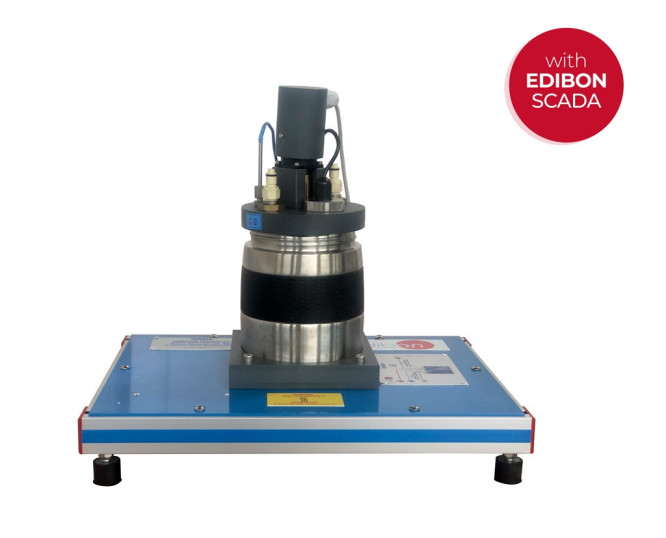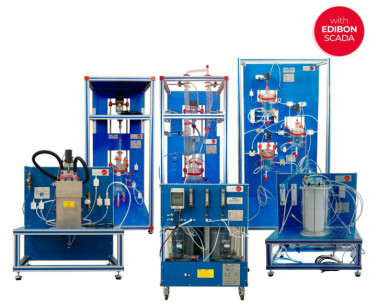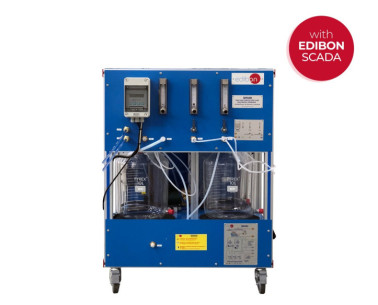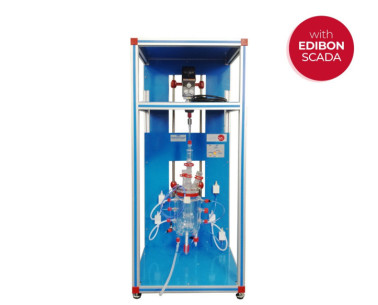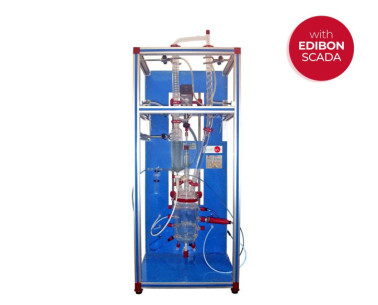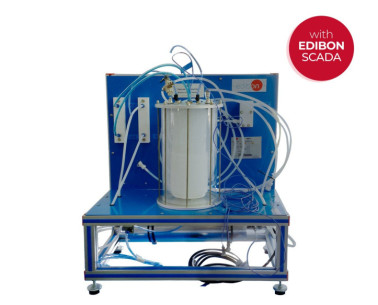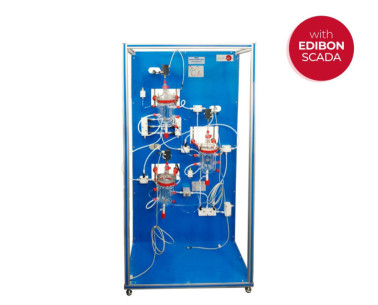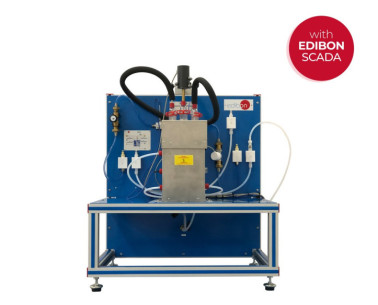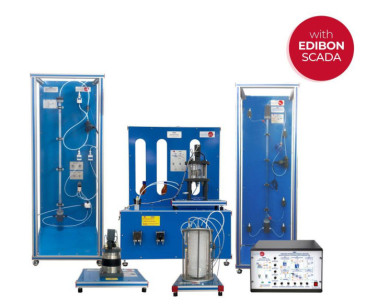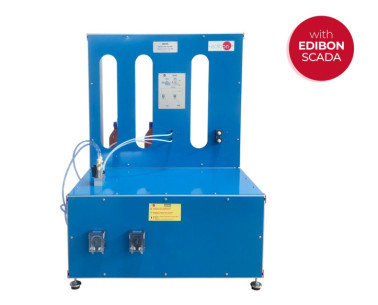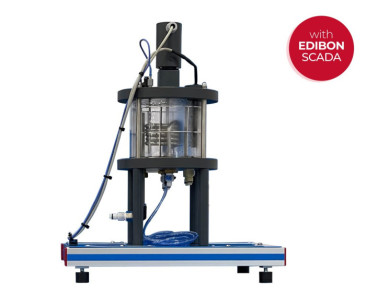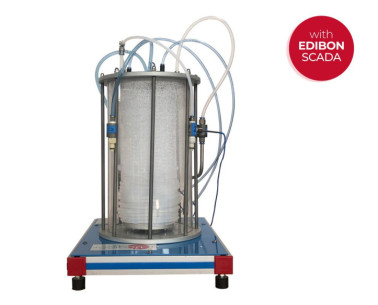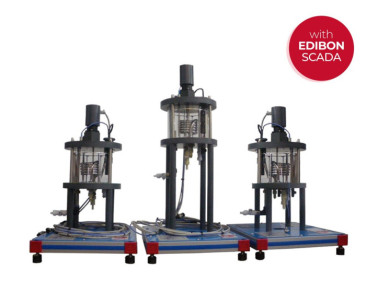QRDC Reator Descontínuo para QRC, Controlado por Computador (PC)
SISTEMAS INOVADORES
The Computer Controlled Batch Reactor for QRC, "QRDC", designed by EDIBON, enables the study and kinetic analysis of homogeneous liquid-liquid reactions, as well as the demonstration of adiabatic and isothermal reactions. This unit offers a wide range of opportunities for investigating reaction kinetics, ranging from sensor calibration to the formulation of velocity equations and the determination of ionic conductivities.
Expansões
LABORATÓRIOS
NOTÍCIAS RELACIONADAS
Descrição Geral
The Computer Controlled Batch Reactor for QRC, "QRDC", designed by EDIBON, enables the study and kinetic analysis of homogeneous liquid-liquid reactions, as well as the demonstration of adiabatic and isothermal reactions.
This unit offers a wide range of opportunities for investigating reaction kinetics, ranging from sensor calibration to the formulation of velocity equations and the determination of ionic conductivities. Its ability to operate in both batch and continuous modes facilitates detailed analysis of effects such as mixing, variation of kinetic constants with temperature, and comparison of theoretical and experimental data.
Moreover, the discontinuous reactor is ideal for studying various chemical reactions, such as chemical synthesis, precipitation, neutralization, and oxidation-reduction. It also allows for demonstrating the impact of different reaction parameters, such as reactant concentration, temperature, and reaction time. Especially in adiabatic reactions, where there is no heat transfer with the surroundings, the adiabatic discontinuous reactor ensures ideal conditions for studying reactions in detail.
To work with this reactor, the Base and Service Unit, "QUSC", is required, which supplies the necessary reagents and thermostatic water for proper operation.
These Computer Controlled Units are supplied with EDIBON Computer Control System (SCADA), and includes: The unit itself + a Control Interface Box + a Data Acquisition Board + Computer Control, Data Acquisition and Data Management Software Packages, for controlling the process and all parameters involved in the process.
EXERCÍCIOS E PRÁTICAS GUIADAS
EXERCÍCIOS PRÁTICOS GUIADOS INCLUÍDOS NO MANUAL
- Determination of the ionic conductivities.
- Batch operation. Calculation of the order of the reaction referred to the ethyl-acetate. Initial velocity method.
- Batch operation. Determination of the order of the reaction referred to the sodium hydroxide. Initial velocity method.
- Batch operation. Determination of the speed constant, the initial concentration of the sodium hydroxide is constant.
- Batch operation. Determination of the speed constant, the initial concentration of the ethyl acetate is constant.
- Formulation of the speed equation.
- Batch operation. Variation of the kinetic constant when the temperature is not constant: Arrhenius equation.
- Batch operation. Comparison of the theoretical and the experimental conversion: Deviation from the ideality.
- Calculation of the heat transference coefficient of the coil.
- Calculation of the hydrolysis reaction enthalpy.
- Batch operation. Mixture effects.
- Conductivity measurement system: conductimeter.
- Sensors calibration.
EXERCÍCIOS MAIS PRÁTICOS A SEREM FEITOS COM A UNIDADE
- Many students view results simultaneously. To view all results in real time in the classroom by means of a projector or an electronic whiteboard.
- Open Control, Multicontrol and Real Time Control. This unit allows intrinsically and/or extrinsically to change the span, gains, proportional, integral, derivate parameters, etc, in real time.
- The Computer Control System with SCADA and PID Control allow a real industrial simulation.
- This unit is totally safe as uses mechanical, electrical and electronic, and software safety devices.
- This unit can be used for doing applied research.
- This unit can be used for giving training courses to Industries even to other Technical Education Institutions.
- Control of the unit process through the control interface box without the computer.
- Visualization of all the sensors values used in the unit process.
- By using PLC-PI additional 19 more exercises can be done.
- Several other exercises can be done and designed by the user.
EQUIPAMENTOS COMPLEMENTARES
Unidade Base e de Serviço para QRQC
Reator Isotérmico com Agitador
Reator Isotérmico com Agitador e Destilação
Reator de Fluxo Tubular
Reatores com Agitador em Série
Reator Adiabático e Isotérmico
Reatores Químicos, Controlados por Computador (PC)
Unidade Base e de Serviço para QRC
Reator Contínuo de Tanque Agitado para QRC, Controlado por Computador (PC)
Reator de Fluxo Tubular para QRC, Controlado por Computador (PC)
Reatores de Tanque Agitado em Série para QRC, Controlados por Computador (PC)
Qualidade

Serviço pós-venda

 Preferências de cookies
Preferências de cookies

